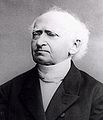Erlangen theology
The Erlangen theology (also: Erlanger Schule , rarely: Franconian awakening theology ) is a theological direction within Protestant awakening theology that emerged in Erlangen .
Origin and meaning
The Erlanger theology - also called Erlanger School - belongs to the field of neo-Lutheran denominational theology. However, this orientation does not have a representative approach, as for example with Ernst Wilhelm Hengstenberg . Sometimes the Erlangen school is also completely counted as part of the neo-Lutheranism.
Its roots lay in the awakening movement of the early 19th century, in which the belief in reason of rationalism, which had long been rooted in theology ( see there on development), was resolutely contradicted. The representatives of the Erlangen School who gathered at the then still small Erlangen University were still predominantly non-theologians. Only Christian Krafft was not a layman. The orientalist Johann Arnold Kanne (1819–1824 in Erlangen), the romantic philosopher Gotthilf Heinrich von Schubert (1819–1827 in Erlangen) and the geologist and educator Karl Georg von Raumer were also active. Even Friedrich Schelling lectures 1821-1823, then Schleiermacher and Hegel's work and contributions Theodor Lehmus ' looked enormous. Through the latter, the work of the philosophical writer Johann Georg Hamann gained influence on Erlangen in a way that should not be underestimated:
Hamann, as is often emphasized in recent research , anticipated important key data from the beginning Erlangen School, such as the "extrarational" experience of rebirth , the "condescension" of God in salvation history and the rediscovery of Luther in his life and work . And if, as Friedrich von Roth writes, "among all Germans who have been since Luther [...] perhaps none of them were more similar in meaning and speech to JG Hamann," then it is not surprising that Erlangen was in the 19th century became a "[...] center of Hamann worship and a place for Hamann studies" ( Friedrich Wilhelm Kantzenbach ).
representatives
The aforementioned Friedrich Roth was also (together with Friedrich Immanuel Niethammer ) the editor of a little book entitled Die Weisheit D. Martin Luther (3 vols. 1825-1838), which vividly documents the newly awakened interest in Luther. Roth, later appointed President of the Munich Upper Consistory by King Ludwig I , was then responsible in this position for the decisive appointments of Adolf Harleß , Johann Wilhelm Friedrich Höfling , Gottfried Thomasius , Hermann Olshausen and Johann Christian Konrad von Hofmann .
The main organ of the Erlangen School, which was just emerging, became the Homiletic-Liturgical Correspondence Sheet (HLC), which not only conveyed the regained piety , but also did it in an unusually polemical way , sometimes approaching satire or parody . The brothers August Bomhard and Heinrich Bomhard stood out here - who, for example , knew what to say about the rationalist preachers of their time:
- “ The moral sermons are reminiscent of that housefather who had his children paint a roast goose on the wall, on which they were allowed to rub the bread every Sunday for a delicious snack. "(Homiletic-liturgical correspondence sheet 1826, p. 313 ff)
The theology of Erlangen did not begin with rational knowledge or critical research into Scripture , but with the re-establishment of man, his so-called rebirth in faith. This experience of rebirth also included the supra-individual factuality of church norms (scripture and confession ). Revelation corresponded to it as a counterpart in which the subject was no longer man (and his ratio ), but God. A basis on which (as I said) Luther and the Confessional Scriptures could now be rediscovered:
- “ I cannot describe the surprise and emotion with which I found that their [ sc. The Confessions] conformed to what I have become certain of from Scripture and from the experience of faith. "(Harleß)
In addition to the aforementioned representatives of the Erlangen theology Harleß, Höfling, Thomasius ( Kenosis theology ), Olshausen, and Hofmann, Reinhold Frank and Theodosius Harnack should also be mentioned. Adolf Harleß, in turn, worked in Leipzig on Franz Delitzsch , Karl Friedrich August Kahnis and, through Hofmann, also on Christoph Ernst Luthardt .
literature
- Karlmann Beyschlag : The Erlangen theology . Erlangen 1993.
- Martin Hein : Lutheran Confession and Erlangen Theology in the 19th Century . Gütersloh 1984.
- Martin Hein: Erlangen . In: Theologische Realenzyklopädie (TRE). Volume 10, de Gruyter, Berlin / New York 1982, ISBN 3-11-008575-5 , pp. 159-164.
- Friedrich Wilhelm Kantzenbach : The Erlangen theology. Basic lines of their development within the history of the theological faculty 1743–1877 . Evang. Press association for Bavaria 1960.
- Friedrich Wilhelm Kantzenbach: Evangelical Spirit and Faith in Modern Bavaria . Munich 1980.
- Matthias Simon: The inner renewal of the theological faculty Erlangen in 1833 . In: Journal for Bavarian Church History 30 (1961), pp. 51–69.
-
Notger Slenczka : Studies on Erlangen Theology :
- Volume 1: Faith and its Reason. FHR von Frank, his discussion with A. Ritschl and the continuation of his program by L. Ihmels (= FSÖTh 85). Goettingen 1998.
- Volume 1: Self-Constitution and Experience of God. W. Elert's interpretation of modern subjectivity (= FSÖTh 86). Göttingen 1999.
- Gottfried Thomasius: The reawakening of Protestant life in the Lutheran Church of Bavaria (1800-1840) . Erlangen 1867.
- Friedrich Wilhelm Winter: Erlangen theology and Luther research in the 19th century (= The Lutheran Church. History and Design , 16). Gütersloh 1995.









